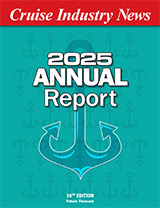Following the end of the U.S. trade embargo, Cuba will pursue a limited Bermuda-style cruise policy versus the open-ended model found elsewhere in the Caribbean, allowing calls by no more than five modem 2,000 to 3,000-passenger cruise ships per day to Havana. According to a representative of Silares, the Cuban Ministry of Transportation-controlled company, which will oversee all cruise and ferry traffic to all ports throughout the island, Cuba will award slots to selected clients who will be able to keep vessels in port for multiple days in return for payment of the appropriate tariff.
In an exclusive interview with Cruise Industry News, the Silares representative noted that Havana already receives a moderate level of primarily European cruise business, with up to four ships calling in a single day in Havana upon occasion. In 2001, Cuba overall expects a total of 340 ship calls and 140,000 passengers. “But the real explosion will come when American cruise companies are able to call in Cuba,” he said, explaining, “When the U.S. embargo is lifted, everyone will want to come, but Cuba does not want to receive all ships interested in corning to Cuba – Havana could handle 15 ships at once, but it will only accept a maximum of five.” The limitation will allow roughly 10,000 passengers per day into Havana, which would still make the port the largest in the Caribbean if allotments are filled year-round; at the same time, the limitation will help keep cruise crowds in Havana at manageable levels, and will provide Silares with a strong position in terms of negotiating passenger fees. “Bermuda allows only a limited number of ships and gets around $60 per passenger,” noted the Silares representative, “while Playa del Carmen and other ports get around $2.”
It is believed that Cuba, unlike other Caribbean islands, will indeed be able to dictate terms with the cruise industry post-embargo, as Bermuda currently does, due to the pent-up demand of American travelers – with some industry insiders dubbing Cuba “the holy grail of the cruise industry,” and its opening to U.S. business a potentially major event for cruise-stock valuations.
While Havana will be the primary port of Cuba, it will not be the only cruise port. “People who want to go to Cuba really want to go to Havana,” be said, “so 85 percent of the future cruise passengers will probably go there” – either by disembarking from one of the five ships in Havana itself, or by traveling to Havana from two nearby ports which will also accept cruise business, Mariel and Matanzas. Meanwhile, on the south side of the island, said the Silares representative, there is the port of Santiago de Cuba, the second largest city in the country.
There is also Cienfuegos, “which many Americans will be interested in because it is the port of the colonial town of Trinidad.” Offshore, cruise ships may call at the Isle of Youth. “We will have 114 calls in Santiago de Cuba in 2001 and 60 to 80 calls in the Isle of Youth,” said the Silares representative. The Cuban administration developed its post embargo cruise policy only recently, according to the Silares representative, who noted, “Within the last year, a lot of people have dedicated a great deal of time to this.” In particular, he noted that the newly created policy will provide centralized channels of communication for those cruise companies interested in calling in Cuba.
“There is only one organization that any cruise or passenger ferry operation has to deal with for any port in Cuba – Silares – and there is only one port agent for all passenger vessels – Servimar,” he said, noting that both currently have main offices in Havana.
Outlining the particulars of the Havana cruise facilities, the Silares representative explained that in addition to the main terminal currently in use, Terminal Sierra Maestra (two berths, length: 742.5 feet, draft: 33 feet), a nearby terminal with the same configuration, Terminal 3 (two berths, length: 742.5 feet, draft: 33 feet), is available for cruise calls, as is one pier across the harbor (length: 1,320 feet; draft 36.3 feet). In addition, a project is currently underway that will add mooring dolphins to both Terminal Sierra Maestra and Terminal 3, allowing ships in excess of 990 feet to use berths in these locations.
Ships currently calling at the Havana facilities include Valtur Prima, Universe Explorer, Sundream, Princess Danea, Black Prince, Black Watch, Olvia, Emerald and Riviera I (ex-Don Juan).
The Terminal Sierra Maestra was fully restored in 1995 as part of a joint venture between the Cuban Ministry of Transportation and Costa Crociere (the latter divesting its interest following the 1997 takeover by Carnival Corp.). A Cruise Indust,y News correspondent visiting the terminal recently found it on par with modem North American facilities, featuring a spacious central hallway dotted with palm trees, boutiques, and a display of antique cars, with Tropicana-style dancing girls greeting amvmg passengers and a centralized location directly adjacent to the historic district of Old Havana.
Old Havana itself was found to be extremely visitor friendly, with well-marked streets and security assured day and night by a visible police presence, featuring forts, museums, scenic plazas, tobacco factories, music, local arts and crafts, as well as landmark hotels and restaurants.



